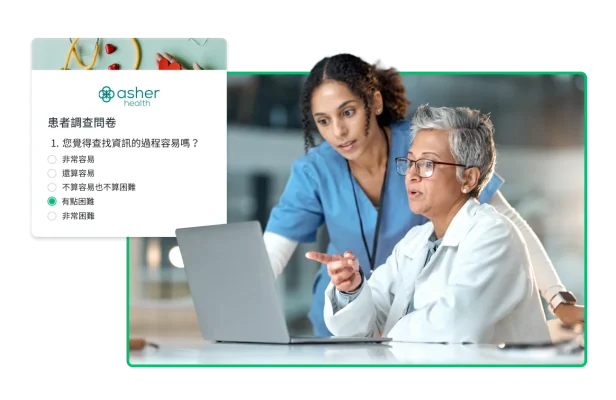





探索我們的資源
精選文章

準確計算 Net Promoter® Score 並探索提示來改善評分。

您的員工感到快樂嗎?本文將說明如何製作有效的調查問卷問題來一探究竟。

探索為您團隊協調適當會議時間的簡單方法。

您的調查問卷需要多少名受訪者?使用我們的樣本大小計算工具,瞭解最佳結果。
調查問卷最佳做法

調查問卷最佳作法與設計準則
像調查專家一樣設計調查問卷、收集回覆和分析資料。
瞭解如何建立調查問卷、收集回覆和分析資料,以推動更理想的商業決策。
取得即時的意見反應以衡量意見,並根據即時資料做出決策。
瞭解最常見的調查問卷偏差,以及如何在研究當中避開這些偏差。
認識用來衡量意見、觀感和行為最可靠的題型之一,並瞭解如何在下一份調查問卷中使用它。
探索常見的調查問卷問題,並瞭解如何建立可產生最佳結果的有效調查問卷。
客戶意見反應

如何建立成功的客戶意見反應計畫
瞭解收集和使用意見反應以改善產品、服務和客戶關係的最佳做法。
瞭解如何利用客戶費力度分數來減少摩擦並提升忠誠度。
瞭解如何計算 NPS 和建立調查問卷以衡量客戶體驗和滿意度。
探索 NPS 的優點和限制,以及為什麼其廣泛用於衡量客戶忠誠度及預測業務成長。
瞭解如何撰寫更優質的客戶滿意度調查問卷問題,以利收集可化為行動的深入解析。
衡量服務品質的五個面向,將有助您找到新的方法來取悅顧客並提升他們的體驗。
市場研究

市場研究:是什麼、重要性和新手指南
瞭解這種以資料優先的策略,如何產生對消費者、情感及更廣泛市場的可行深入解析。
瞭解如何用幾分鐘建立有效的市場研究調查問卷。
瞭解次級研究與初級研究的差異,以及為什麼您應該在業務中使用次級研究。
取得所需資訊,以便更妥善地制定關於產品及服務的決策。
您的調查結果是否具有統計顯著性?使用此計算器確保調查問卷結果中的信心水準。
員工意見

員工意見反應:提示、範例和範本
瞭解如何提出正確的問題、建立可靠的員工意見反應計畫,並使用結果提升員工留任率。
瞭解應該提出哪些問題,以協助您改善招募流程,並吸引最優秀的應徵者。
探索使用員工調查問卷提升參與度、識別職場問題並改善組織文化的好處。
訓練調查問卷評估訓練計畫的成效,並識別需要改善的地方,為您的員工提供支援。
了解透過明確溝通、認可和包容性培養健康工作文化的策略。
取得調查問卷範本和專家指導,以協助貴組織建立更具包容性的文化。
表單

建立線上表單
使用 SurveyMonkey 輕鬆建立線上表單,並立即開始收集回覆。
取得關於設計有效線上表單的指引,包括結構、問題類型和使用者體驗的最佳做法。
建立方便自訂和填寫的線上報名表單。從多種範本中選擇以符合您的需求。
直接從客戶、客戶端及其他人員收集意見反應,以協助您改善業務、產品或品牌。
取得建立 RSVP 表單的提示,並瞭解如何收集和追蹤訪客回覆,以高效管理活動出席情況。
透過嵌入式表單提升回覆率、擷取聯絡資訊,並簡化報名和申請流程。
研究與分析

如何分析調查問卷資料:方法與範例
瞭解如何有效地分析調查問卷資料,並輕鬆打造更優質的調查問卷。
透過正確的資訊和工具,您可以運用統計方法分析調查問卷資料,輕鬆達到專家的技巧。
深入瞭解探索型研究,並學習將其應用於您研究工作的四種方法。
透過測試假設並檢查結果,瞭解因果關係並進行明智決策。
趕快查看我們整理出來的定量研究需知,確保貴公司蒐集到的資料能發揮最大功效。
瞭解如何計算誤差範圍,並立即使用我們的線上計算器進行衡量。
產品開發

如何利用近即時的意見回饋快速建立更好的產品
瞭解如何在產品開發流程中使用調查問卷收集客戶意見反應、識別需求,並指導產品改善工作。
瞭解如何透過篩選創意,確保您打造的產品受到研究和分析支援,具有成功的潛力。
評估客戶的願付價格,並提供關於定價策略和市場需求的深入解析。
在產品推出前後收集深入解析,以提升產品和客戶的滿意度。
讓可信賴的目標受眾驗證您的產品概念和想法,一個小時以內就能完成。
瞭解如何規劃、設計、傳送並分析概念測試調查問卷,以改善您的下一次廣告活動、產品發佈等。
活動管理

活動意見管理:活動前和活動後調查問卷
取得提示和範本,讓您的下一個活動從開始到結束圓滿成功。
瞭解應該詢問哪些活動調查問卷問題,以便在每個活動階段收集寶貴的意見反應。
取得為活動規劃量身打造之預先建立好的調查問卷範本,讓收集出席者偏好和期望的過程變得更加輕鬆。
透過使用調查問卷向出席者收集意見反應,以便將活動辦得更成功。
協助收集可行深入解析的專家提示,以改善您的下一場企業活動或派對。
做好準備、有條不紊,並使用 SurveyMonkey 工具來順暢執行活動。
行銷

行銷調查問卷:範例問題和範例等
建立行銷調查問卷只需要幾分鐘,然後就能利用收集到的資料來改善客戶滿意度、改良產品、調整價格、發想創意廣告活動等等。
發展市場見解,以制定更明智且策略化的業務決策。
瞭解執行廣告測試的最佳做法,從激盪出問題到分析結果,有助您找到最佳選擇。
追蹤品牌表現,並瞭解品牌隨時間發展的情況。
瞭解如何透過原創研究,為內容行銷取得有說服力的資料。
探索行業專業人士如何在行銷中運用 AI (人工智慧),並探討 SurveyMonkey 關於 AI (人工智慧) 使用的研究統計資料。
教育調查問卷

為學校、教師和學生設計的教育調查問卷
我們與美國教育部和哈佛教育研究所合作,設計了推動教育改善工作的調查問卷範本。
向學生、教師和家長傳送教育調查問卷,以瞭解您學校或大學的運作情況等方面。
瞭解學生的需求、偏好和挑戰,以便打造提供支援的教育環境。
透過學生調查問卷問題改變您的教學方式。取得對課程、活動等方面的真實意見反應,促進更好的學習效果。
使用 SurveyMonkey 和哈佛教育研究所的 K-12 調查問卷範本,以提升家長的參與度。
透過從調查問卷收集的資料和深入解析,為您的學術研究增加深度。
醫療保健調查問卷

醫療保健調查問卷:問題和範本
使用醫療保健調查問卷收集患者意見反應、改善照護品質,並支援醫療機構的決策過程。
使用患者滿意度調查問卷評估醫療保健體驗,並推動患者照護改善工作。
使用此調查問卷範本,評估並改善您醫療保健組織內的患者安全文化。
瞭解如何使用調查問卷收集臨床研究、患者結果和醫療保健進展所需的關鍵資料。
瞭解 SurveyMonkey 如何協助客戶滿足 HIPAA 合規要求。
取得評估問題樣本、醫療保健調查問卷範例,以及瞭解如何撰寫具有專業水準的醫療保健調查問卷問題。
Net Promoter、Net Promoter Score 和 NPS 是 Satmetrix Systems, Inc.、Bain & Company, Inc. 和 Fred Reichheld 的商標。

